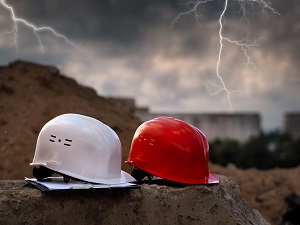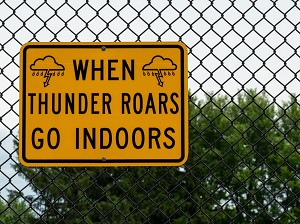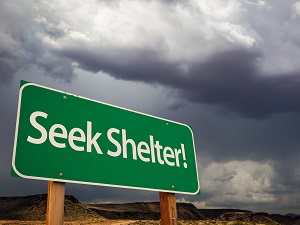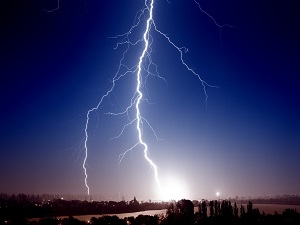Lightning strikes can cause serious injuries or death when workers are outdoors during thunderstorms. While lightning is often overlooked as an occupational hazard, awareness about lightning hazards is critical to ensure workers’ safety.

Lightning is a dangerous natural force. According to OSHA, in the United States, over 300 people are struck by lightning every year and unfortunately many of those people die from their injuries.
Workers whose jobs involve working outdoors in open spaces, on or near tall objects, or near explosives or conductive materials have significant exposure to lightning risks. Worker activities at higher risk for lightning hazards include:
- Heavy Equipment Operation
- Roofing
- Power Utility Field Repair
- Construction/Scaffolding Work
- Steel Work/Telecommunications
- Explosives Handling or Storage
- Plumbing and Pipe Fitting
- Building Maintenance
- Logging
- Farming and Field Labor
- Lawn Services/Landscaping
- Airport Ground Personnel Operations
- Pool and Beach Lifeguarding
Lightning is a giant spark of electricity in the atmosphere between clouds or between a cloud and the ground. Thunderstorms always include lightning and any thunder you hear is being caused by lightning.

Before and during outdoor work, check local weather reports and keep an eye out for darkening clouds and increasing wind speeds, which can indicate developing thunderstorms. Lightning is unpredictable and can strike outside the heaviest rainfall areas or even up to 10 miles away from any rainfall.
Many lightning victims are caught outside during a storm because they did not act promptly to get to a safe place, or they go back outside too soon after a storm has passed.
If there are signs of an approaching thunderstorm, workers should not begin any task that they cannot quickly stop if they need to get to safety. If you hear thunder when working outdoors, even a distant rumble, get to a safe place immediately.
OSHA General Duty Clause 5(a)(1) Each employer shall furnish to each of his employees employment and a place of employment which are free from recognized hazards that are causing or are likely to cause death or serious physical harm to his employees.
During storms or high winds, OSHA prohibits:
- work on or from scaffolds
- crane hoists
- work on top of walls
Scaffolding work may continue if a qualified person determines it is safe and personal fall protection or wind screens are provided. Crane hoists may proceed only if a qualified person determines it is safe.

Outdoor workers should know ahead of time where to go if the weather turns dangerous and they need to get to safety. NOAA recommends workers seek out fully-enclosed buildings with electrical wiring and plumbing. In modern buildings, the interior wiring and plumbing will act as an earth ground.
A building is a safe shelter as long as you are not in contact with anything that can conduct electricity like electrical equipment or cords, plumbing fixtures, and corded phones. Do not lean against concrete walls or floors which may have metal bars inside.
If safe building structures are not accessible, workers can seek shelter in hard-topped metal vehicles with the windows rolled up. Remain in the shelter, or vehicle, for at least 30 minutes after hearing the last sound of thunder.
After hearing thunder, do not use corded phones, except in an emergency. Cell phones and cordless phones may be used safely.
All workers should be informed on and understand inclement weather policies and procedures. People are most commonly struck by lightning at the beginning or ending of a thunderstorm, outside of heavy rain, and in smaller storms, when they have a false sense of security and tend to take more chances.
A competent person should evaluate the site before work begins and throughout the workday to ensure a safe working environment that is free of hazards, including dangerous weather. If there is not a competent person on site to evaluate and inform on hazards, or if a worker is alone, then audio or visual contact should be provided, especially during inclement weather.

If workers are caught outside during a thunderstorm with no safe place available to retreat to, NOAA recommends the following precautions to take to decrease a worker’s risk of being struck by lightning.
Lightning is likely to strike the tallest objects in a given area—you should not be the tallest object. Avoid isolated tall trees, hilltops, utility poles, cell phone towers, cranes, large equipment, ladders, scaffolding, or rooftops. Avoid open areas like fields. Never lie flat on the ground.
Retreat to a dense area of smaller trees that are surrounded by larger trees or move to a low-lying area like a valley or ditch but be sure to watch for flooding in these areas. Avoid water, and immediately get out of and away from bodies of water. Water does not attract lightning, but it is a good conductor of electricity.
Avoid wiring, plumbing, and fencing. Lightning can travel long distances through metal. Stay away from metal objects, equipment, and surfaces that can conduct electricity. Do not seek shelter in sheds, pavilions, tents, or covered porches because they do not provide adequate protection from lightning.
Rubber-soled shoes and rubber tires do not provide protection from lightning.


